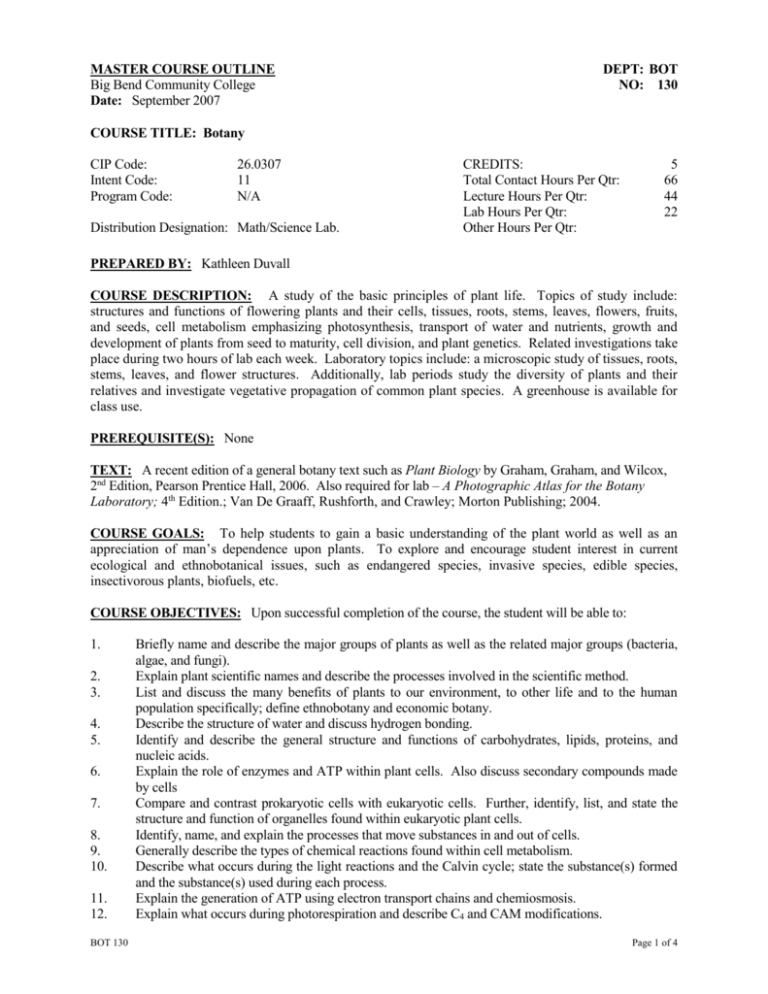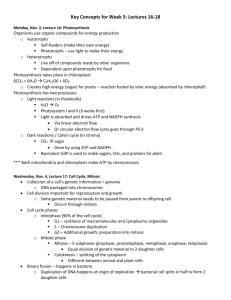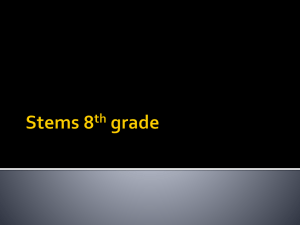
MASTER COURSE OUTLINE
Big Bend Community College
Date: September 2007
DEPT: BOT
NO: 130
COURSE TITLE: Botany
CIP Code:
Intent Code:
Program Code:
26.0307
11
N/A
Distribution Designation: Math/Science Lab.
CREDITS:
Total Contact Hours Per Qtr:
Lecture Hours Per Qtr:
Lab Hours Per Qtr:
Other Hours Per Qtr:
5
66
44
22
PREPARED BY: Kathleen Duvall
COURSE DESCRIPTION: A study of the basic principles of plant life. Topics of study include:
structures and functions of flowering plants and their cells, tissues, roots, stems, leaves, flowers, fruits,
and seeds, cell metabolism emphasizing photosynthesis, transport of water and nutrients, growth and
development of plants from seed to maturity, cell division, and plant genetics. Related investigations take
place during two hours of lab each week. Laboratory topics include: a microscopic study of tissues, roots,
stems, leaves, and flower structures. Additionally, lab periods study the diversity of plants and their
relatives and investigate vegetative propagation of common plant species. A greenhouse is available for
class use.
PREREQUISITE(S): None
TEXT: A recent edition of a general botany text such as Plant Biology by Graham, Graham, and Wilcox,
2nd Edition, Pearson Prentice Hall, 2006. Also required for lab – A Photographic Atlas for the Botany
Laboratory; 4th Edition.; Van De Graaff, Rushforth, and Crawley; Morton Publishing; 2004.
COURSE GOALS: To help students to gain a basic understanding of the plant world as well as an
appreciation of man’s dependence upon plants. To explore and encourage student interest in current
ecological and ethnobotanical issues, such as endangered species, invasive species, edible species,
insectivorous plants, biofuels, etc.
COURSE OBJECTIVES: Upon successful completion of the course, the student will be able to:
1.
2.
3.
4.
5.
6.
7.
8.
9.
10.
11.
12.
BOT 130
Briefly name and describe the major groups of plants as well as the related major groups (bacteria,
algae, and fungi).
Explain plant scientific names and describe the processes involved in the scientific method.
List and discuss the many benefits of plants to our environment, to other life and to the human
population specifically; define ethnobotany and economic botany.
Describe the structure of water and discuss hydrogen bonding.
Identify and describe the general structure and functions of carbohydrates, lipids, proteins, and
nucleic acids.
Explain the role of enzymes and ATP within plant cells. Also discuss secondary compounds made
by cells
Compare and contrast prokaryotic cells with eukaryotic cells. Further, identify, list, and state the
structure and function of organelles found within eukaryotic plant cells.
Identify, name, and explain the processes that move substances in and out of cells.
Generally describe the types of chemical reactions found within cell metabolism.
Describe what occurs during the light reactions and the Calvin cycle; state the substance(s) formed
and the substance(s) used during each process.
Explain the generation of ATP using electron transport chains and chemiosmosis.
Explain what occurs during photorespiration and describe C4 and CAM modifications.
Page 1 of 4
13.
14.
15.
16.
17.
18.
19.
20.
21.
22.
23.
24.
25.
Describe what occurs during the stages of cellular respiration; account for total ATP production.
List the events that occur during each phase of mitosis, describe how cytokinesis occurs in plant
cells, and discuss what happens during the rest of the cell cycle.
Name the organs of the plant body; further, name the primary and secondary meristems that account
for plant growth. Finally, list and describe the primary and secondary plant tissues that make up the
plant body.
Describe the structures and state the functions of plant stems, roots, and leaves. List specialized
plant organs, including carnivorous plants.
Explain the movement of sugars and water throughout the plant, defining transpiration. Describe
root absorption and generally describe plant nutrition.
Name and describe the effects of the five types of plant hormones. Further, explain how a plant
responds to light, gravity, touch, drought, and other external stimuli.
List the events that occur during the phases of meiosis. Compare meiosis with mitosis, especially
with respect to outcome.
Explain what a life cycle diagram is; draw and label a representative diagram.
Describe Mendel’s experiments and state Mendel’s two laws, giving an example of each.
Use a Punnett square to solve simple genetic problems involving up to two genetic traits at once.
Explain the terms, monocot and dicot, then compare the characteristics of these two types of
angiosperms.
Diagram and explain flower structure, embryo development, seed structure and germination.
Diagram and label a typical angiosperm life cycle.
Name and identify at least six different types of inflorescences; and name and describe the different
types of fruits.
COURSE CONTENT OUTLINE:
General Introduction
Major Groups of Plants and Their Relatives
Bacteria, Protists, and Fungi
Scientific Names and the Scientific Method
Plants’ Essential Role in the Biosphere
Ethnobotany, Economic Botany, and Agriculture
Preserving Genetic Resources and Natural Plant Products
Molecules of Life
Water and Hydrogen Bonding
Dehydration Synthesis and Hydrolysis
Carbohydrates and Lipids
Proteins and Nucleic Acids
Enzymes and ATP
Secondary Compounds
Cells – Their Structures and Functions
Prokaryotic and Eukaryotic Cells
Membrane Transport – Diffusion and Osmosis
Organelles of Plant Cells
Photosynthesis and Cellular Respiration
Endergonic and Exergonic Reactions
Coupled Reactions, Oxidation and Reduction, and Pathways
Properties of Light, Light Reactions, and the Calvin Cycle
Electron Transport Chains, Chemiosmosis, and ATP Generation
Photorespiration, C4 and CAM Plants
Glycolysis, the Krebs Cycle, and ATP Generation
Fermentation
BOT 130
Page 2 of 4
Plant Growth, Structure, and Development
Cell Cycle, Mitosis, and Cytokinesis
Plant Bodies, Plant Organs, and Symmetry
Meristems – Primary and Secondary
Simple and Complex Primary Plant Tissues
Secondary Plant Tissues
Asexual Reproduction
Stems, Roots, and Leaves – Structure and Functions
Xylem and Phloem – Movement of Water and Sugars
Herbaceous Stems and Specialized Stems
Woody Stems, Vascular Cambium, and Secondary Tissues
Structure and Function of Roots, Specialized Roots
Plant Nutrition, Absorption, and Beneficial Microbes
Structure and Functions of Leaves
Transpiration and Water Movement
Specialized and Modified Leaves, Carnivorous Plants
Plant Behavior, Reproduction, and Life Cycles
Plant Signal Response and Hormones
Auxins, Cytokinins, Ethylene, Gibberellins, and Abscisic Acid
Phytochromes and Light Responses
Gravity, Touch, Flooding, Heat, Drought, Cold and Defensive Responses
Sexual vs. Asexual Reproduction
Meiosis and Comparing with Mitosis
Types of Life Cycles and Their Diagrams
Genetics
Mendel’s Experiments
Mendel’s First Law and Inheritance Patterns of Single Genes
Linked Genes, Mendel’s Second Law, and Inheritance Patterns of Two Genes
Naming and Organizing Plants and Related Groups
Scientific Names, Dichotomous Keys, and Phylogenetic Trees
Plant Family Characteristics
Prokaryotes, Protists, and Fungi
Seedless Plants – Mosses and Ferns
Seed Plants – Gymnosperms and Angiosperms
Angiosperms
Monocot vs. Dicot
Flower Structure, Symmetry, and Inflorescences
Angiosperm Life Cycle
Embryo Development, Seed Structure, and Germination
Types of Fruits
Laboratory Exercises Explore the Following Topics:
Plant Propagation
Microscope: Viewing Cells & Tissues
Roots & Stems
Leaves & Photosynthesis
Flowers, Fruits, and Seeds
BOT 130
Mitosis, Meiosis, and Life Cycles
Bacteria, Protista, & Fungi
Bryophytes and Ferns
Gymnosperms & Angiosperms
Page 3 of 4
EVALUATION METHODS/GRADING PROCEDURES:
Evaluation will be accomplished by exams, quizzes, assignments, reports, and projects. The overall
course grade is based on the following weighted categories. Any slight adjustments to these category
percentages will be printed and distributed to students at the beginning of each quarter.
Lecture Exams
Homework, Projects, In-Class Quizzes, and In-Class Assignments
Lab Quizzes, Lab Reports, Lab Project, and Lab Exam
60%
20%
20%
The final grade will be based on an overall course percentage according to the approximate schedule
below. The instructor may adjust the grade scale slightly as deemed necessary.
100 - 96%
95 - 90%
89 - 84%
83 - 77%
4.0
3.9 - 3.5
3.4 - 3.0
2.9 - 2.5
76 - 70%
69 - 64%
63 - 57%
56 - 0%
2.4 - 2.0
1.9 - 1.5
1.4 - 0.7
0.0
Lab is an essential part of this class and is required for credit. Students missing more than two labs or
missing the mandatory lab final will not be given credit for this course. All lab exams are practical exams in
which students rotate through stations that each contain two questions and usually present a hands-on
exhibit. Diagrams, models, 35mm slides, and microscope slides are all commonly used. Lab exam question
types include identification, analysis, and prediction of results.
PLANNED TEACHING METHODS/LEARNING STRATEGIES:
X Lecture
X Laboratory
Supervised Clinical
X Small Group Discussion
X Audiovisual
Individualized Instruction
X Special Project
Other (List)
Division Chair Approval
BOT 130
Page 4 of 4











